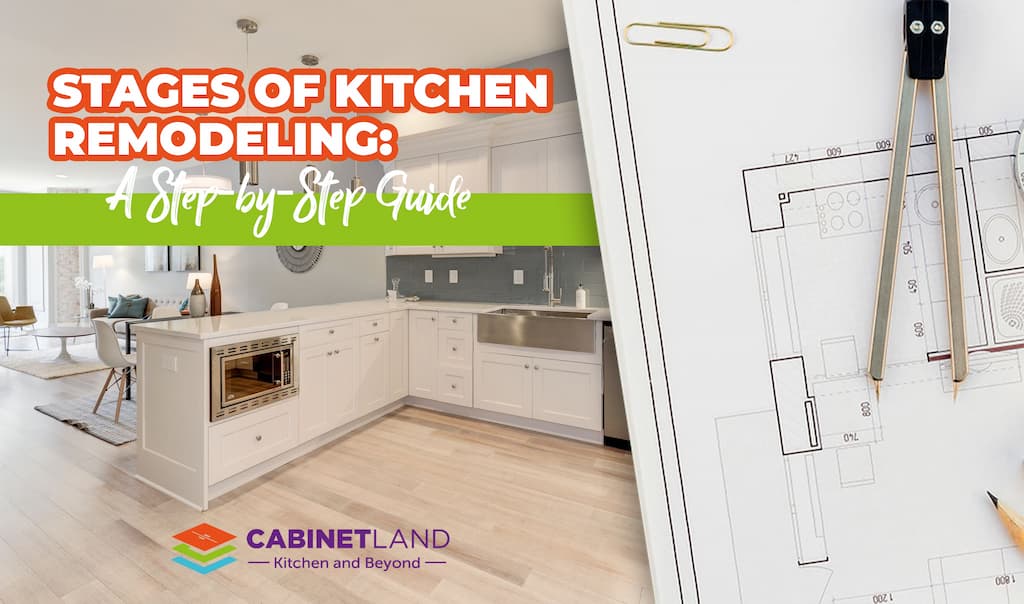Table of Contents
ToggleStages of Kitchen Remodeling
Kitchen remodeling is a significant endeavor that enhances the aesthetic appeal of your home and adds value to it. Since the kitchen is one of your household’s most frequently used spaces, investing in its renovation can transform it into a modern, functional, and inviting area. The kitchen remodeling journey can be lengthy and challenging, like a bathroom makeover. Yet, it’s essential to focus on the following crucial phases:
As for bathroom renovation, the kitchen remodeling process is also long and tiresome. Yet, there are essential phases to pay attention to kitchen remodeling:
- The Planning
- The Installation And Reconstruction
- The Cleaning and Finishing
Every phase has distinct properties that make them unique and obligatory for kitchen remodeling. They also have sub-categories that create the foundation for remodeling.
1. The Planning
Planning is one of the most critical phases of kitchen remodeling because the other phases will also be affected without a good strategy. It would be best to first research to make a good plan and create your dream kitchen.
a. Research: Building Blocks
The research lets you find the best budget-friendly or price-performance kitchen remodeling options. Because this phase will make the foundations, it is best to take your time. Correcting your wrong choices will be tiresome and expensive if you don’t plan thoroughly during this period.
If you are still determining what material you will choose for your kitchen floors, countertops, or cabinets, you can always get help from a professional kitchen remodeling firm. If you apply for professional services, the company will give you a 3D model and AR of different designs to maximize your kitchen space and help you see how the project will look in your house. These designs will cover every aspect of the project to enable you to find the best choice for your dream kitchen, from what kind of material to use to which color and shape.
b. Designs: Shape and Shade
Your kitchen’s layout is pivotal to its functionality. Choose between the classic U-shape or the expansive Double-L, among others. Colors also play a significant role in setting the ambiance. Whether it’s rich browns’ warmth or neutral tones’ purity, every color tells a story. When deciding on design elements, aim for a cohesive theme that resonates with your style.
c. Budget: Balancing Dreams and Reality
Your budget is one of the first things you should consider for kitchen remodeling. A plan without distinct funding would be less reliable than a specific budget. Your budget should also have compensation for minor inconveniences during the remodeling process.
According to the NKBA (National Kitchen & Bath Association), the cost of an average kitchen remodeling consists of these percentages:
- While %29 of the overall budget goes to Cabinets and hardware,
- Installation takes about %17,
- Countertops about %10 and
- The Appliances will take about %15 of the overall budget
The rest, however, will be spent on possible problems and foundational properties such as plumbing, lighting, flooring, etc. Also, the national average of minor kitchen remodeling will cost you about 15,000 dollars, according to NKBA reports. However, the project may cost higher according to the size of the kitchen. But the most crucial point is that good and detailed planning at the beginning of the kitchen remodeling project will optimize the budget and use it efficiently. So, getting help from an experienced remodeling company is vital.
NKBA also says that you should spend at least %10-15 percent of the total value of your house on kitchen remodeling or constructing it from the start. Also, depending on the countertops or cabinetry you select, your kitchen will value your house’s price more. For example, countertops from natural stones such as quartz or granite raise the value of your home. It would help if you also considered these things while creating a budget for the kitchen remodeling process.
d. Ordering: Turning Dreams into Deliverables
Once your design is crystal clear and budget set, it’s ordering time. Depending on your selections, delivery times vary. Custom designs take longer than stock items, so plan accordingly.
2. The Installation and Reconstruction: Breathing Life into Plans
Once you finish planning, the ordering and the installation are the following steps to your dream kitchen. However, kitchen remodeling is not just replacing the cabinetry or the countertops. It also includes systems such as water and electricity, which require permits. Kitchen remodeling may require government permits because if it is not planned and done correctly, it can affect the whole neighborhood and your safety. However, you don’t need to deal with them because your contractor will handle them.
a. Securing Permits: Green Lights for Construction
Acquiring necessary permits can take anywhere from 6-8 weeks. The process ensures your renovations are safe and up to local standards.
b. Installation
When all items of your order arrive and get permits (if required), it’s time to start the work. It is a tiring but exciting phase as you see your kitchen being built daily. In this project phase, many things need to be handled as planned.
Because kitchens are one of the rooms used as the foundation of the house, everything done should be detailed and fragile. So, the uninstallation, the reconstruction, and the installation itself, the whole process can take up to 4-5 weeks based on its complexity and size. Establishing a substitute kitchen in the house will be convenient during installation and simplify your life. So, please ensure you have a room or space as a substitute kitchen to avoid inconveniences. However, here are the processes of the installation:
First, the uninstallation begins with removing the old countertops, cabinets, etc. This process may be easier and quicker according to the kitchen condition. Once everything is removed from your old kitchen, the reconstruction process begins.
The water system, electrical outlets, and cables are arranged according to your dream kitchen remodeling in this reconstruction process. The foundation itself is rechecked to ensure there won’t be any problems after installation, which would require much work. However, the reconstruction process prevents any inconveniences that can happen.
Now, the time has come for the installation to begin. Every little detail of your dream kitchen will come to life, from the floors and electrical outlets to cabinets and countertops. If you are a person who is into construction, seeing your dream kitchen come to life one by one will undoubtedly make your day.
c. Inspection: A Seal of Approval
After the installation of your dream kitchen, an inspection will be made to ensure everything is functional. The durability of the cabinetry, countertops, and all other considerations will be checked with you. Even though a comprehensive inspection is made while changing the house’s water systems and electrical foundation, it is always better to check again to prevent further problems.
3. The Cleaning and Finishing
This phase is the last part of your kitchen remodeling process. After the installation and reconstruction are done, the cleaning process begins. This process is shorter than the installation or reconstruction, and the estimated time for the cleaning is a day for most kitchen remodeling processes.
After the cleaning, the cabinetry will be tested, the countertops will be sealed if needed, and everything will look as new as possible. And there will be only one thing left for you to do: The enjoyment part.
After long weeks of planning, ordering, and installing, your new kitchen will be exactly how you wanted it. Not only will it create a unique ambiance and feeling in your house, but it will also raise the value of your home. So, it is a win-win situation for your aesthetic and economic wants.
To Sum Up
Kitchen remodeling is more than just a home improvement project; it’s a long-term investment in your comfort, lifestyle, and property value. While the process can be daunting, breaking it down into crucial phases—Planning, Installation and Reconstruction, and Cleaning and Finishing—can make it more manageable and ensure a successful outcome. Detailed planning and budgeting are your foundation stones, guided by professional advice. The installation phase breathes life into your meticulously planned designs, and the final cleaning and finishing allow you to step back and admire your dream kitchen turned into reality.
It’s a journey filled with decisions, creativity, and anticipation, but the result is well worth it. Your kitchen isn’t just a cooking space; it’s a gathering place, a focal point of daily life, and now, it’s precisely how you envisioned it. Not only does it bring joy and convenience to your daily routine, but it also adds significant value to your home. So, as you enjoy your newly remodeled kitchen, you’ll find that the efforts, time, and investment were well spent, offering both aesthetic pleasure and financial benefits.
Frequently Asked Questions About Remodeling
Yes, it is worth remodeling your kitchen for both aesthetical and monetary purposes. The kitchen remodeling process not only gives you your dream kitchen but also raises the value of your house. Every little piece has value, from the new cabinetry to the countertops and even the floor.
Yes, it is worth remodeling your kitchen for both aesthetical and monetary purposes. The kitchen remodeling process not only gives you your dream kitchen but also raises the value of your house. Every little piece has value, from the new cabinetry to the countertops and even the floor.
Renovation is reinforcing or repairing the old cabinetry or parts of the kitchen into the new or repaired ones. However, remodeling is the process of changing the old ones with the new ones and requires a lot more time than the renovation process.
Yes. While both remodeling processes require a lot of time and effort, kitchen remodeling tends to be more expensive than bath remodeling because of the vast difference in size. The cabinetry, the countertops, the walls, the island, the shape of the kitchen, and so many other things are indigenous to kitchen remodeling.
The consensus is this: You should put at least %10-15 of your total home value into kitchen remodeling. Normally, the average-sized kitchen remodeling costs about 15-20 thousand, while the bigger ones can also cost up to 50 thousand. For a minor remodeling, however, that number can go low as 5 thousand as well.
Kitchen cabinetry takes up the most space in a kitchen remodeling budget. They are crucial for kitchens because of their usage and the effect they create in the ambiance. According to NKBA (National Kitchen & Bathroom Association), kitchen cabinetry can take up to %30 of the overall remodeling budget.



